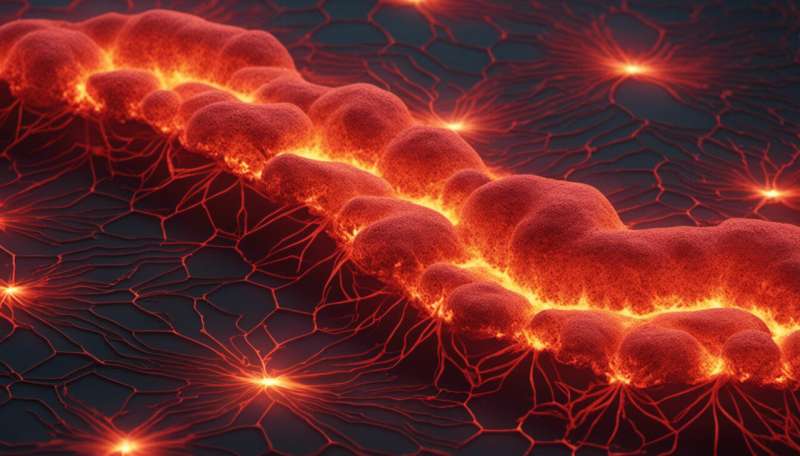Credit: AI-generated image (disclaimer)
(Phys.org)—A team of researchers with Dresden University of Technology in Germany has apparently solved the riddle of why lava sometimes forms into hexagonal towers as it cools. In their paper published in Physical Review Letters, the team describes how they put together a computer model that ultimately showed how such shapes can form.
Scientists and other people have been amused, piqued and inspired by some of the geometric shapes that come about as lava cools—Devils Tower in Wyoming, for example, or Giant's Causeway in Northern Ireland, both feature cooled lava in the form of hexagonal structures. Upon seeing them, most wonder how they could have come about—after all, most things in nature are random, or perhaps round. Hexagons seem like they could come about only due to intervention by us humans. Now it appears, the team in Germany has cracked the riddle of how nature could have made it happen.
It is all about heat differential and the way cracks form, the team reports. They made these discoveries by building a model very similar to those used by engineers to build bridges or aircraft parts. It allowed them to account for the characteristics of the lava, both when it was hot, and as it cooled. That allowed them to see that after some bit of lava stopped flowing, as it cooled, the inner parts cooled faster than the outer parts, leading to shrinkage and the formation of cracks adjacent to one another, which meant they formed at 90 degree angles. Then as the lava cooled even more and more shrinkage occurred, the cracks made their way down into the lava below which was still solidifying—that forced the cracks to grow larger, forcing the angle between them to change to approximately 120 degrees, which occurred because it was the point at which the largest amount of energy was released—and it is also, of course, the same angle degree found in hexagonal structures.
The hexagonal structure were then maintained as the lava cooled down to ambient temperatures and the shape was persevered—meanwhile, the same process occurred around it, causing the creation of other lava formations that looked very nearly just like it.
More information: Why Hexagonal Basalt Columns? Phys. Rev. Lett. 115, 154301 – Published 7 October 2015. dx.doi.org/10.1103/PhysRevLett.115.154301
ABSTRACT
Basalt columns with their preferably hexagonal cross sections are a fascinating example of pattern formation by crack propagation. Junctions of three propagating crack faces rearrange such that the initial right angles between them tend to approach 120°, which enables the cracks to form a pattern of regular hexagons. To promote understanding of the path on which the ideal configuration can be reached, two periodically repeatable models are presented here involving linear elastic fracture mechanics and applying the principle of maximum energy release rate. They describe the evolution of the crack pattern as a transition from rectangular start configuration to the hexagonal pattern. This is done analytically and by means of three-dimensional finite element simulation. The latter technique reproduces the curved crack path involved in this transition.
Journal information: Physical Review Letters
© 2015 Phys.org






















